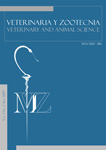Autores/as
Resumen
RESUMEN: Se realizó un experimento para determinar los requerimientos nutricionales de Proteína Bruta (PB) en aves de postura livianas post-pico de producción durante el primer ciclo de postura. En el experimento se utilizaron 300 gallinas Hy Line W36® de 38 semanas de edad, distribuidas en un diseño experimental irrestrictamente al azar, con cinco tratamientos, cinco repeticiones y 12 aves por unidad experimental. Las aves se alimentaron con una dieta básica de maíz, sorgo y torta de soya, con 2.800 kcal de
EM/kg y cinco niveles de PB (14, 15, 16, 17 y 18%). No se observaron diferencias estadísticas significativas (P>0,05) en la producción de huevo, masa de huevo, consumo de alimento, conversión alimenticia y ganancia de peso corporal de las aves sometidas a los diferentes tratamientos. Por lo tanto, el rendimiento productivo de las aves es independiente del nivel de proteína bruta, siempre y cuando se garanticen los niveles adecuados de energía y aminoácidos limitantes.
Palabras clave
Citas
Fasuyi, A.O.; Dairo, F.S.A.; Olujimi, O.T. Protein supplementary quality of vegetable leaf meal (Amaranthus cruentus) in the diets of laying hens: Egg laying performance, egg quality and heamatological implications. J. Food Agric. Environ, v.5, p.294-300, 2007.
Filho, J.J.; Vilar da Silva, J.H.; Lindolfo da Silva, E. et al. Methionine + cystine requirements of semiheavy laying hens from the starter to peak of egg production. R. Bras. Zootec., v.35, p.1063- 1069, 2006.
Halle, I.; Danicke, S.; Rauch, H.W. Untersuchungen zur Aminosaurenversorgung von Legehybriden. Arch. Geflugelkd, v.69, p.167-174, 2005.
Hy-line internacional, variedad w-36. Guía de manejo comercial. Manual. Estados Unidos. p.11-12 y 18, 2010.
Hulan, H.W.; Mcrae, K.B.; Proudfoot, F.G. Performance Comparisons of Phased Protein Dietary Regimens Fed to Commercials Leghorns During the Laying Period. Agriculture Canadá, Research Station, Kentville, Nova Scotia, Poultry Science, v67, 1447-1454, 1985.
Hussein, A.S.; Cantor, A.H.; Pescatore, A.J. et al. Effect of Dietary Protein and Energy Levels on Pullet Development. Poultry Science, v.75: 973- 978, 1996.
Ibrahim, S.; Blair, R.; Jacob, J. Using reduced protein diets to minimize nitrogen excretion of layer. En: Department of Animal Science. Abstracs. University of BC, Vancouver, BC. V6T1Z4, 1992.
Jensen, L.S.; Penz, A.M. Metabolism and Nutrition. Influence of Protein Concentration, Amino acid Supplementation, and Daily Time of access to High or Low – Protein Diets on Egg Weight, Production and Components in Laying Hens. Poultry Science, v.70: p.2460-2466, 1991.
Johnston, S.A.; Gous, R.M. Modelling the changes in the proportions of the egg components during a laying cycle. Br. Poult. Sci., v.48, p.347-353, 2007.
Keshavarz, K. The effect of different dietary protein levels in the rearing and laying periods on the performance of white leghorn chickens. Poultry Science, v.63, p.2229-2240, 1984.
Keshavarz, K.; Nakajima, S. The effect of dietary manipulations of energy, protein, and fat during the growing and laying periods on early egg weight and egg components. Poult. Sci., v.74, p.50-61, 1995.
Keshavarz, K.; Austic, R.E. The use of low-protein, low-phosphorus, amino acid- and phytasesupplemented diets on laying hen performance and nitrogen and phosphorus excretion. Poult. Sci., v.83, p.75-83, 2004.
Kleyn, F.J.; Gous, R.M. Response of Laying Hens to Energy and Amino acids. Departament of Animal Science and Poultry Science, University of Natal, Pietermaritzburg, South Africa 8: 113, 1988.
Lee, K.H.; Ohh, Y.S. Effects of nutrient levels and feeding regimen of a.m. and p.m. on laying hen performances and feed cost. Korean J. Poult. Sci., v.29, p.195-204, 2002.
Leeson, S.; Summers, J. Nutrition of the chicken. 4th ed. Univ. Books, Guelph, Ontario, Canada, 2001.
Lemme, A.; Rostagno, H.S.; Knox, A. et al. Responses of laying hens to graded levels of dietary methionine. 22nd World’s Poult. Conf., Istanbul, Turkey. (Abstr.), 2004.
Nescheim, C.M. Phase Feeding. Feedstufs, v.40, n.30, p.24, 1968.
Nivas, S.C.; Sunde, M.L. Protein Requeriments of Layers Per Day and Phase Feeding. Departament of Poultry Science, University of Winsconsin, Madison, Winsconsin. 53706. p.1672-1678, 1969.
Novak, C.L.; Yakout, H.; Scheideler, S.E. The combined effects of dietary lysine and total sulfur amino acid level on egg production parameters and egg components in Dekalb Delta laying hens. Poult. Sci., v.83, p.977-984, 2004.
NRC. Nutrient Requirements of Poultry. 9th rev. ed. Natl. Acad. Press, Washington, DC, 1994. Reid, B.L. Estimated daily protein requeriments of laying hens. Poultry Science, v.55, p.1641- 1645, 1976.
Robbins, K.R.; Saxton, A.; Southern, L. Estimation of nutrient requirements using broken-line regression analysis. J. Anim. Sci., ( E-Suppl.) 84:E155–E165, 2006.
Rostagno, H.S.; Taeixeir, A.L.; Donzele, J.L. et al. Tablas Brasileñas para Aves y Cerdos. Composición de Alimentos y Requerimientos Nutricionales. 2da Edición. Universidad Federal de Vicosa. Brasil, 2005.
Sakomura, N.K. Modelling energy utilization in broiler breeders, laying hens and broilers. Braz. J. Poult. Sci., v.6, p.1-11, 2004.
SAS Institute. SAS/STAT User’s Guide. Version 6. 5th ed. SAS Inst. Inc., Cary, NC. 2002.
Summers, J.D.; Leeson, S. Influence of diets varying in nutrient density on the development and reproductive performance of White Leghorn pullets. Poult. Sci., v.72, p.1500-1509, 1993.

 PDF
PDF
 FLIP
FLIP










